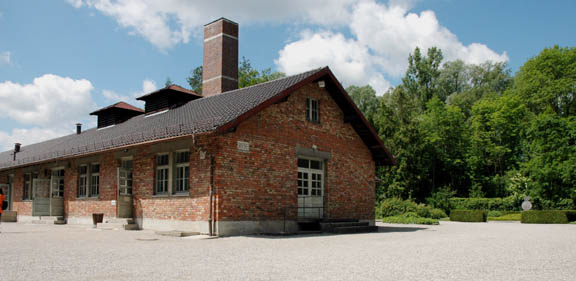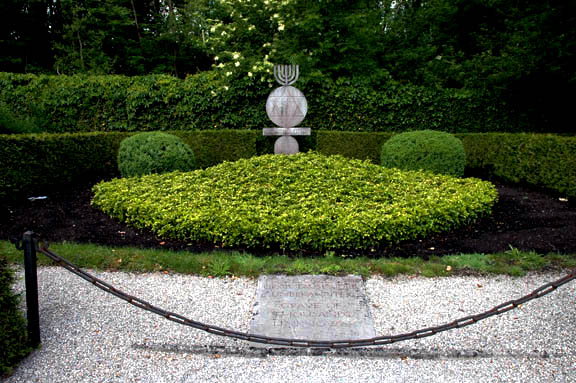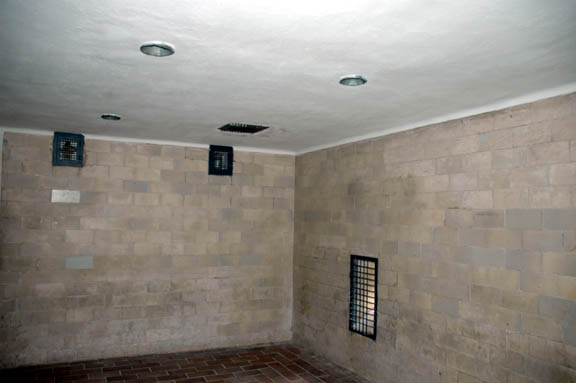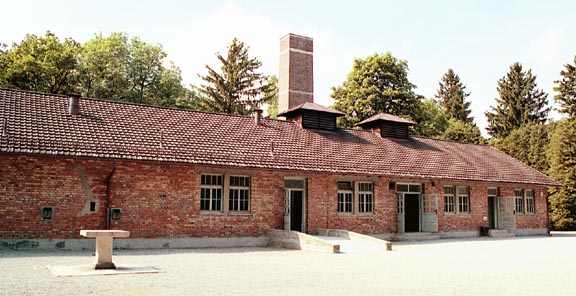Dachau Gas Chamber The photo above, taken in May 2007, shows the north end of Baracke X, the building where the gas chamber is located at Dachau. On the right, behind the building, is the spot where the ashes of thousands of unknown prisoners were buried. The photo below shows a closeup of the spot where the ashes were buried. Note the monument in the background, which has a Menorah on top and a Star of David in the middle. Another grave of thousands of unknown victims at Dachau is marked with a Christian Cross, although the Nazis did not bury the ashes of Jews and Christians in separate graves.  Soon after the liberation of the Dachau concentration camp on April 29, 1945, a US War Crimes Investigation Team was brought to Dachau and an attempt was made to find some of the bodies of the prisoners who had been gassed. It was the policy to burn the bodies in all the camps, but in the last months of the war, the bodies at Dachau had been buried on a hill called Leitenberg. One of the mass graves on Leitenberg was opened and Dr. Charles Larson, a leading forensic pathologist, who was with the US Army's Judge Advocate General's Department (JAGD), performed autopsies on hundreds of bodies without finding any that showed evidence of poison gas. Shortly before the proceedings of the Nuremberg IMT began on November 20, 1945, the trial of the staff members of the Dachau concentration camp by an American Military Tribunal started on November 15, 1945, but no charges were made against any of the accused with regard to killing prisoners in the 5 gas chambers at Dachau. The charges against all of the Dachau accused war criminals were as follows: ... acting in pursuance of a common design to commit the acts hereinafter alleged, and as members of the staff of Dachau Concentration Camp and camps subsidiary thereto, did, at, or in the vicinity of DACHAU and LANDSBERG, Germany, between about 1 January 1942 and about 29 April 1945, willfully, deliberately and wrongfully encourage, aid, abet and participate in the subjection of civilian nationals of nations then at war with the then German Reich to cruelties and mistreatment, including killings, beatings, tortures, starvation, abuses and indignities, the exact names and numbers of such civilian nationals being unknown but aggregating many thousands who were then and there in the custody of the German Reich in exercise of belligerent control. A second charge against the Dachau accused was worded exactly the same as the one quoted above, except that the alleged victims were "members of the armed forces of the Allies." Since the names and nationality of the victims who were killed in the gas chamber were unknown, it was impossible to determine if they had been "members of the armed forces of the Allies" or "civilian nationals of nations then at war with the then German Reich," so there could be no charge of gassing made during the proceedings against the Dachau staff members in the American Military Tribunal that began in November 1945. The charges against Hermann Göring, Ernst Kaltenbrunner and others in the Nuremberg International Military Tribunal included Crimes Against Humanity which covered all atrocities against all nationalities.  The photo above shows the northeast corner of the Dachau gas chamber. Near the floor is an opening through which Zyklon-B pellets could be thrown into the room to provide poison gas to kill the victims. Just below the ceiling are two light fixture boxes, one of which was used as a vent to introduce poison gas into the room, according to the American made film shown at the Nuremberg International Military Tribunal on November 29, 1945. On the ceiling, in the photo above, are empty holes where dummy shower heads used to be. The gas also came through the shower heads, according to the Official Army Report, although visitors today can see that there were no pipes connected to the dummy shower heads. The square opening on the ceiling, in the photo above, is one of the two vents through which the poison gas fumes could escape after the gassing was completed, although there was no machinery to pump the air out. Both ceiling vents are connected to one pipe on the roof of the building, which is shown on the left in the photo below.  Up until 1960, it was an accepted fact that a gas chamber, disguised as a shower room, had been used to murder prisoners at the Dachau concentration camp. Then on August 19, 1960 on page 16, Die Zeit, a German magazine, published a letter from Martin Broszat, head of the Institute for Contemporary History in Munich. Herr Broszat stated that the Dachau gas chamber had never been completed and had not been put into operation. In 1976, Simon Wiesenthal, the famous Nazi hunter who was himself a prisoner at the Mauthausen concentration camp, wrote a letter to a magazine called Books and Bookmen in which he stated that there were no gas chambers on German soil. However, Martin Zaidenstadt, a self-proclaimed survivor of the camp who, for many years, came back to visit it every day, told the tourists that the Dachau gas chamber was indeed used for mass murder. The staff at the Dachau Memorial Site allowed Zaidenstadt to walk around the camp and ask visitors for money, out of sympathy for his suffering at Dachau, even though the camp records show that he was never a prisoner there. The controversy became heated after Fred Leuchter, an American gas chamber expert, testified at the second trial of Ernst Zündel, who had been charged with spreading false news by publishing a booklet entitled "Did Six Million Really Die?" in Canada. After examining the gas chambers at Auschwitz, Majdanek, Hartheim Castle and Dachau, Leuchter wrote a paper, known as The Leuchter Report, which he now admits contains an obvious mistake. Leuchter wrote in his report that there are two floor drains in the gas chamber at Dachau which he says are connected to the main sewer line. There are actually six floor drains in the Dachau gas chamber. However, there are two floor drains in the morgue that is right next to the gas chamber. One of these floor drains in the morgue was covered by a wooden board in May 2007. When I visited Dachau in May 2001, a portable sign in the gas chamber informed visitors that the fake shower room was built as a gas chamber but was never used as a gas chamber, or never put into operation. A display in the waiting room of the gas chamber building in May 2001 showed a copy of a letter from Dr. Sigmund Rascher, which proves that a gas chamber was planned at Dachau. Both the sign in the gas chamber and the copy of the letter were gone when I visited Dachau in May 2003 and again in May 2007. In May 2007, a sign at the south end of Baracke X informed visitors that four of the five gas chambers in the Baracke X building were used to disinfect clothing in an effort to prevent typhus, a disease which is spread by lice. All five of the gas chambers at Dachau were designed to use Zyklon B pellets for gassing. The photo below shows the huge mound of clothing found near the disinfection chambers when the camp was liberated.  A pamphlet handed out by the Dachau museum in May 1997 contained this startling information about the homicidal gas chamber: "Upon orders of the SS-Wirtschaftsverwaltungshauptamt (SS-Economic-Administrative Main Office) in Berlin a gas chamber was installed. This gas chamber, camouflaged as a shower room, was not used. The prisoners selected for 'gassing' were transported from Dachau to the Hartheim Castle, near Linz (Austria) or to other camps. In Hartheim alone 3166 prisoners were gassed between January 1942 and November 1944." History of Dachau gas chamberOfficial Army Report on gas chamberCongressmen visit Gas Chamber on May 3, 1945Interior of Gas ChamberExterior of Gas ChamberDisinfection Gas ChambersBack to Gas Chamber indexBack to Dachau indexHomeThis page was last updated on October 13, 2009 |